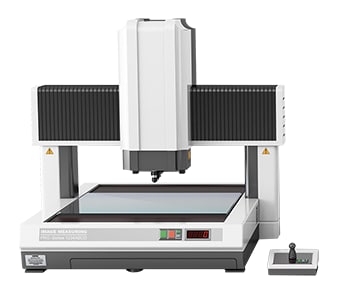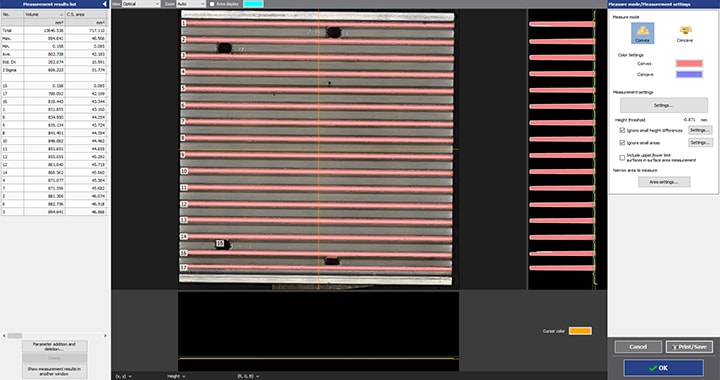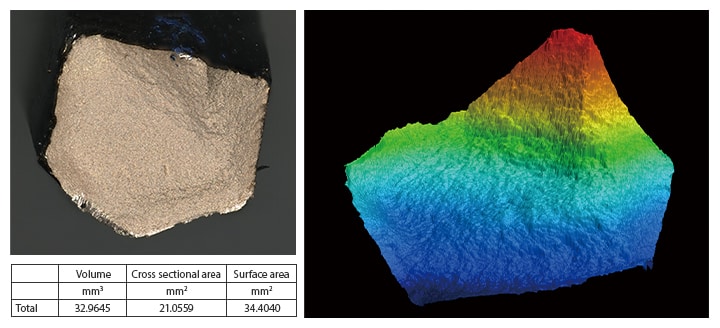A Method for Accurate and Easy Measurement of Surface Area

Surface area generally refers to the surface area of a three-dimensional object such as a cube, sphere, or cone. However, these measurements involve a high degree of difficulty. As a substitute, optical microscope, digital microscope, or CNC image measuring instrument are used. With these tools, users can calculate surface area based on 2D data, but they cannot gather accurate measurement of the surface area. Although measurement is possible using a displacement sensor or roughness meter, these instruments measure only points and lines, requiring much labour and time to measure the surface area.
Below, we describe the surface area of various measurement targets, as well as problems in the measurement methods and a solution to these problems.
- Surface Area
- Problems in Conventional Surface Area Measurement
- Solution to Problems in Surface Area Measurement
- Summary: Dramatic Improvement and Higher Efficiency in Difficult Surface Area Measurement
Surface Area
Surface area refers to the area of a 3D surface, and is an important indicator when evaluating functionality, together with texture, adhesion, sliding performance, heat dissipation, and surface roughness. For example, for a metal fracture surface or friction surface, PGA, or engraving with a laser marker, measuring the surface area can provide a variety of information.
Metal fracture surface area
Analysis of metal fracture surfaces can be an effective method for investigating the causes of fractures. By observing the metal fracture surface in detail, the cause of the fracture can to some extent be identified based on the fracture morphology. Measuring the surface area also makes it possible to calculate characteristics such as the percent ductile fracture, which indicates the percentage of brittle fracture out of the entire fracture surface.
Wear surface area
As roughness or waviness exists on the surfaces of all solid objects, contact even between nominally flat surfaces is in fact contact between protrusions on the surfaces (true contact area). Measuring the surface area of the wear surface allows us to identify the cause of the wear. The true contact area can be calculated based on the surface area and the roughness of the wear surface; this makes it possible to easily identify the conditions of wear.
Surface area of PGA (Pin Grid Array)
PGA (Pin Grid Array) is one of type of IC package. Because the pins are mounted at high density and are inserted into sockets, it will be impossible to mount the PGA onto the socket if there is any deviation in pin thickness, height, or angle. For this reason, it is important to measure characteristics including pin height, volume, and surface area at a large number of locations.
Surface area of laser marker engraving
The quality of laser marker engraving can be evaluated by measuring the volume, surface area, and cross-section area of the engraved part. These values can be useful when setting the laser irradiation intensity, material laser light absorptivity, spot diameter, and other parameters.
Problems in Conventional Surface Area Measurement
Optical microscopes, CNC image measuring instrument, roughness meters, and displacement sensors are used for conventional measurement of surface area. However, there are problems with accuracy including substituting results of surface area measurement and calculating surface area based on 2D data. Along with that, a lot of time is required for measurement due to the high level of difficulty.
Problems in surface area measurement using an optical microscope

Measurement using an optical microscope is effective for small targets. Microscopes that have been developed in recent years feature support for quantification of measured data and improved ease of operation. However, when the target is large, a microscope cannot be used to measure surface area, area, and volume for the entire target. Even when measurement is possible, extremely large amounts of time and trouble are required to move the target about while measuring it.
Problems in surface area measurement using a CNC image measuring instrument

In general, a CNC image measuring instrument captures the target on the stage using a CCD camera and performs 3D measurement.
Observation using colour images is possible, but the following problems occur when measuring surface area.
- Detection errors may occur when there are protrusions on the product surface due to product defects such as burrs or chipping. In addition, when the measurement points are not set correctly, variation in measurement accuracy will occur.
- When the number of X, Y, Z, or other measurement items increases, the program becomes complex, requiring both advanced expert knowledge and greater numbers of man-hours for configuration. The required measurement man-hours increase in proportion to the number of measurement targets.
Another major problem includes the need for a measurement chamber that needs to be kept at the reference temperature. Along with that accurate measurement cannot be performed by all workplace operators.
Problems in surface area measurement using a roughness meter or displacement sensor
When measuring surface roughness using a roughness meter, measurement in the height direction is limited to points or lines only. As a result, it is necessary to increase the number of measurement points in order to accurately identify the shape. The time for measurement performed by moving a probe or stylus increases in proportion to the number of measurement locations. It is also necessary to adjust the target position after it is installed. Furthermore, the measured values are not reliable because the measurement points may vary depending on the operator.


- A
- Stylus
- B
- Detector
Solution to Problems in Surface Area Measurement
The measuring instruments that are ordinarily used involve problems such as the long time required to position the target, and the fact that measurement of three-dimensional targets and areas is performed by means of point or line contact. To resolve these measurement problems, KEYENCE has developed the 3D Optical Profilometer VR Series.
The VR Series accurately captures the 3D shape of the entire target surface without contacting the target. It also measures the 3D shape by 3D-scanning the target on the stage in as little as one second with high accuracy. The VR Series is capable of instantaneous and quantitative measurement with no errors in measurement results. This section introduces some specific advantages of the VR Series.
Advantage 1: Capable of measuring a wide area of up to 300 mm x 150 mm.
Measurement can be performed simply by placing the target on the stage and pressing a button. Strict positioning or other preparation is not necessary. This makes it possible to perform highly accurate measurement by operators who do not have knowledge or experience related to measuring instruments.

Unlike conventional measuring instruments, the VR Series extracts the features of the target placed on the stage and automatically corrects its position. The strict positioning which previously required much time and effort is no longer necessary. The VR Series can also measure a wide area of up to 300 mm x 150 mm by stitching multiple measurement images. This makes it possible for even an inexperienced operator to easily and instantaneously perform measurement, and eliminates the need to assign a specialised operator to measurement work.
With the VR Series, even a target with a large surface area such as a cooling plate can be measured accurately simply by placing it on the stage and pressing a button.
Advantage 2: Perform quantitative evaluation of surface areas and cross-section areas.
For metal ductile fracture surfaces, it is possible to measure the surface area and cross-section area, and also the ratio of surface area to cross-section area.
The VR Series allows the height data to be used to measure the volume and area of the target, as well as the XY diameter at the specified height. Counting can also be performed at the same time.

Summary: Dramatic Improvement and Higher Efficiency in Difficult Surface Area Measurement
The VR Series can measure 3D target shapes accurately and instantaneously by high-speed 3D scanning without contacting the target. It can solve all the problems faced by conventional measuring instruments in measurement of surface area, volume, cross-section area, and ratio of surface area to cross-section area.
- Volume and surface area can both be measured simultaneously.
- This eliminates variation resulting from human factors, making true quantitative measurement possible.
- Without the need for positioning or other preparation, measurement can be performed simply by placing the target on the stage and pressing a button. This eliminates the need to assign a specialised operator for measurement work.
- 3D shapes can be measured easily at high speeds with high accuracy. This makes it possible to measure a large number of targets in a short time, helping to improve quality.
This system also allows comparisons with past 3D shape data and CAD data, as well as easy data analysis such as distribution within tolerances. It can be used effectively for a wide range of purposes including product development, manufacturing trend analysis, and sampling inspections.


